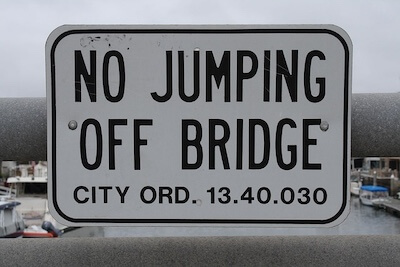Coaching to Improve Nonprofit Policies in the Smaller Organization
- Home
- 80 Small Nonprofit Practices
- Coaching to Improve Nonprofit Policies
In the same way you used the four insights of Coaching to Assist Small Nonprofit Leaders Develop Policy, continue your policy work using Coaching to Improve Nonprofit Policies.
This second part will allow you to examine funding, process, issues verses individuals, and leadership authority.
Don't rush through your review, or lightly cast it off. It may be very revealing, and provide real benefit for your small organization moving forward.
45. Adequate Funding is Allocated for
Matters Covered by Policies

This is Practice 45 of 80
If it is worth having a policy over, it is worth funding if needed. Otherwise, change the policy.
- What policy is running into problems because of lack of money to carry it out?
- Do you wish to keep it?
- How will you provide for implementation of that policy?
- If it can't be funded, how can it be modified to serve your mission?
Why This Practice is Important to Me as a Leadership Coach
Funding is required in order to implement and maintain some policies. Mostly when I coach around this topic there are a lack of funds to fully carry out the policy. For example: paying staff at some particular wage level.
I assist the client to think through ideas and options for addressing whatever the need might be. Solutions may be tactical or found in actually changing the policy to better reflect the reality.
The Key Concept, Attitude or Action That Drives This Practice
BACKING
If you really believe in something you back it with the resources necessary to make it work.
An Expansive Thought
Under-funded policy initiatives contribute to unwelcome challenges.
An Action Point
Check problem policies and ask yourself if a lack of committed resources has anything to do with the problem.
46. Policies Go Through a Thorough
Process of Development and Review

This is Practice 46 of 80
Wise leadership will take the development time to work a policy up through all the major stakeholders whom it will affect.
Explore every angle you can think of. Avoid writing anything if it isn’t really needed. Take the time to get it right, or it could be around to challenge you for a long time.
- Who are the appropriate people to be involved in writing a specific policy?
- Who should be working on it first?
- How could it benefit from going through another filter, representing another viewpoint?
- Has everybody it will affect been consulted?
Why This Practice is Important to Me as an Executive Coach
If all segments of the organization contribute to your policy, it will probably be a well accepted policy. Often policies get created by a small circle of people who all think the same way.
Their thinking might be entirely correct. On the other hand, it might have benefitted from listening to a broader range of ideas or insights from other stakeholders. My job in coaching is to help the client explore who those voices are they might benefit from.
The Key Concept, Attitude or Action That Drives This Practice
PROCESS
A thorough process of consultation and development will pay off.
An Expansive Thought
Increase the involvement of the stakeholders who will be affected by it and you will either come up with a better policy or you will get rid of it altogether.
An Action Point
Ask yourself who really needs to be consulted.
47. Policies Are Used to Deal with
Issues, Not Control Individuals

This is Practice 47 of 88
Whatever comes up that involves individuals is dealt with immediately.
It doesn’t always take a policy to tell you how people ought to be treated. Where people and policies intersect, people are the first concern.
You don’t have to water down a policy to care for a person.
- How would you consider your policies to be "people friendly?"
- Do people get frustrated because of the way something “has” to be done, or by something that “can’t” be done a certain way?
- Was this particular policy written because one person kept "crossing a line?" How has that affected others who don't behave in such a manner?
- How can you deal with the issues without demeaning the person? Most often this means, how can you deal with the behavior of this one individual without imposing onerous conditions on everyone.
- What kind of assistance do you need with this? Who should get involved?
Why This Practice is Important to Me as a Leadership Coach
Deal with individuals personally, not by issuing a new policy. They either don't know and need to know, or they need to experience the consequences.
I meet a lot of frustrated leaders who are weighed down because of "policies" that should never exist.
You've probably played a game that includes dumb laws. "You can't wear blue jeans walking down a certain street." It makes you shake your head. Same with a lot of leaders, but their stuck with it, unless something is done.
The Key Concept, Attitude or Action That Drives This Practice
RESPECT
People deserve respect and policies don't always deliver that.
An Expansive Thought
Most people don't need a policy. They need an explanation.
An Action Point
If someone or some group's behavior is disruptive, deal with it. Only consider formulating a policy after this happens and then only if it is needed.
48. Leadership
is Clear on Their Authority to Carry Out Policy

This is Practice 48 of 88
The Board has given authority to the leadership. They are one hundred percent behind them in following through on policy.
The leadership knows this.
If there are any limits, they are well understood by everyone.
To what extent does the Executive Director, or other appropriate leadership, feel empowered by the Board?
How has the Board historically stood behind the tough decisions the Administrator has had to make in the course of everyday leadership?
What are the
assumed limits to implementation of policy?
Why This Practice is Important to Me as an Executive Coach
If policy originated from some place higher, the leadership needs to understand whether they have authority to carry it out.
Most often in my executive coaching, I run across this when the leader feels there is a disrespect for some particular decision they made. They followed "the policy" but the board, or oftentimes some "power person" on the board disagreed. Who's right?
It can get pretty tangly.
The Key Concept, Attitude or Action That Drives This Practice
EMPOWER
Let people know they are empowered by you to carry out the dictates of policy.
An Expansive Thought
When leaders know that their authority is supported 100% by those they report to, more policy will tend to be well-followed through on.
An Action Point
Let those who need to know, know you stand behind them.
This is the end of the final four sections on Coaching to Improve Nonprofit Policies. To once again review the first four go here.
What Has Been Most Helpful to Your Organization from Coaching to Improve Nonprofit Policies?
Coaching to Improve Nonprofit Policies has added another four points for you to consider. Along with Part One you have eight "touchpoints" to stop and examine in your small organization.
Polices can hold back of free to move forward. What are yours?
Contact me here Privacy Policy
© G.E.Wood and Associates. All Rights Reserved in all media.
G.E. Wood and Associates is an international coaching firm registered in Ontario, Canada
142 Pratt Crescent, Gravenhurst, Ontario, Canada, P1P 1P5